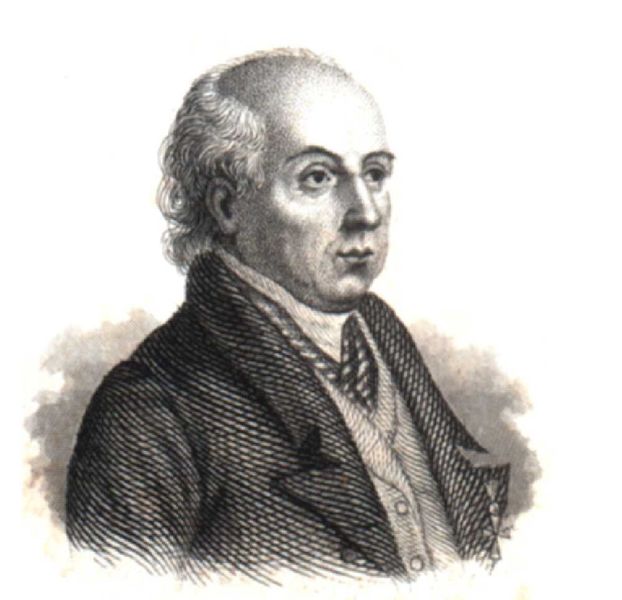Nikolaus Joseph von Jacquin
(in. Nikolaus von Baron Jacquin, 16 lutego 1727 r. - 26 października
1817 r.) był długowiecznym naukowcem, który studiował
medycynę, chemię i botanikę.
Urodził się w Leiden w Holandii, studiował medycynę na Uniwersytecie w
Leiden, ale później przeniósł się do Paryża, a
następnie do Wiednia.
W latach 1754 - 1759 Nikolaus von Jacquin został wysłany do Indii
Zachodnich i Ameryki Środkowej przez Franciszka I do zbierania roślin
do pałacu Schönbrunn, kiedy to zgromadził duży
zbiór zwierząt, roślin i próbek
minerałów.
W 1762 roku Nikolaus von Jacquin został profesorem w przemyśle
wydobywczym na Akademii Górniczej w Schemnitz (obecnie na
Słowacji).
W 1768 roku został mianowany profesorem botaniki i chemii i został
dyrektorem Ogrodu Botanicznego Uniwersytetu Wiedeńskiego.
Za swoją pracę był wyróżniony w 1774 roku. W 1783 roku
został wybrany członkiem zagranicznym Królewskiej Szwedzkiej
Akademii Nauk. W 1806 roku został baronem.
Jego młodszy syn - Emil Gottfried (1767-1792) i jego córka -
Franziska (1769-1850) byli przyjaciółmi Mozarta,
który udzielał lekcji fortepianu Franzisce. Mozart poświęcił
znaczną część swoich prac na rzecz rodziny Jacquin, zwłaszcza
Kegelstatt Trio. Po raz pierwszy zagrał w domu Jacquins w sierpniu 1786
roku z Franziską podczas gry na fortepianie.
Jego syn Franz Joseph (1766-1839) był profesorem botaniki i chemii na
Uniwersytecie w Wiedniu i jest autorem kilku znaczących książek
botanicznych.
Nikolaus Joseph von Jacquin jest upamiętniony dzięki roślinom
Jacquinia
(Theophrastaceae) i Jacquiniella (Orchidaceae).

20 Euro, Nikolaus Joseph von
Jacquin, 2011
Nicholas von Jacquin was a true European. Born in Leiden, Holland, in
1727, he moved to Vienna, where he was commissioned by the Emperor
Franz (husband of Maria Theresa) to lead a natural science expedition
into the Caribbean. Between 1754 and 1759 he visited many Caribbean
islands like St. Vincent, Grenada, Aruba, St. Kitts, Haiti, Jamaica and
Cuba, as well as exploring the coastal regions of Venezuela and
Columbia.
He sent back seven collections of plants, animal and artefacts to
Vienna. Jacquin is regarded as the initiator of the Austrian
expeditions of exploration. The coin shows Jacquin’s portrait
together with “Iris Variegata”, one of his many
discoveries.
The reverse depicts him at work in the Caribbean cataloguing his
botanical discoveries.
*****
20
€ Nicholas von Jacquin silver coin
The Austrian Mint situated in the heart of Vienna is the minting
authority for Austria which meanwhile looks back to a history of 800
years. Today all Austrian Euro and Cent coins are produced here,
whether they are intended for shopping, as an investment or for
collection. Before the Euro the Schilling and Groschen coins were
minted here, and before that - during the monarchy - Crowns, Guilders
and Ducats were struck here.
Issued on
February 23, this release celebrates the life of explorer and Imperial
Botanist, Nicholas von Jacquin. The coin is part of the eurostar
series, which includes 8 countries that are issuing coins this year as
part of the pan-European program celebrating European explorers.
The
coin comes in an attractive box with a numbered certificate of
authenticity.
The obverse of the coin depicts a three quarter
portrait of Jacquin in the upper left half of the design field, along
with a carefully detailed depiction of the plant “iris
variegata” one of his many discoveries, to the right. Beneath
the name of the botanist “Jacquin,” is the privy
mark of the “Europa Star” program. This side of the
coin also depicts the country of issue “Republik
Oesterreich”, Republic of Austria, the face value of 20 euros
as well as the year of issue 2011. This side of the coin was designed
by mint engraver Helmut Andexlinger.
The reverse of the coin shows Jacquin on a tropical
island in the Caribbean. Large banana leaves, as well as a parrot are
seen on left side of the design. The tall-masted sailing ship can be
seen at anchor in the background. Jacquin is depicted writing his notes
on some of the many plant species he identified, some of which no
longer exist today. Chief mint engraver Thomas Pesendorfer designed the
reverse of the coin.
| Face value |
20 Euro
|
| Metal |
900 Silver |
| Size |
34 mm |
| Weight |
18 g |
| Mintage |
50,000 pcs |
| Issuer |
Austrian Mint |
| Quality |
Proof |
| Date of issue |
2011 |
Nicholas von Jacquin was a true European. Born in Leiden, Holland, in
1727, he moved to Vienna, where he was commissioned by the Emperor
Franz (husband of Maria Theresa) to lead a natural science expedition
into the Caribbean.
Between 1754 and 1759 he visited many Caribbean islands like St.
Vincent, Grenada, Aruba, St. Kitts, Haiti, Jamaica and Cuba, as well as
exploring the coastal regions of Venezuela and Columbia. He sent back
seven collections of plants, animal and artifacts to Vienna. Jacquin is
regarded as the initiator of the Austrian expeditions of exploration.














